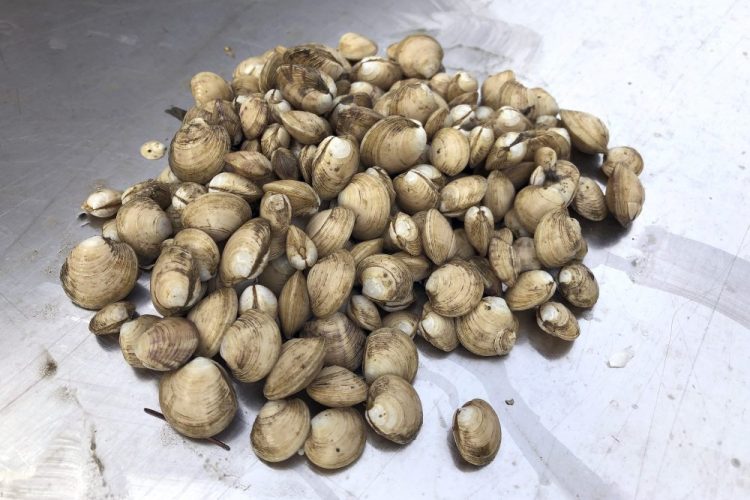GEORGETOWN — Few things are as embedded in Maine’s culture – or its mud – as clams, and an environmental group thinks the key to saving the shellfish might be growing a different kind of bivalve along the state’s coast.
Manomet, based in Plymouth, Massachusetts, is proposing the shellfish shift as a way to beat predators that plague Maine’s clam diggers. Seafood lovers have sought Maine’s softshell clams in chowders and clam rolls for decades, but wild harvesters are collecting fewer of those clams, in part because of the spread of crabs and worms that prey on them.
Manomet thinks the answer might lie in the aquaculture of quahogs, which are a harder species of clam associated more with Rhode Island and Massachusetts. The group is working with four shellfish farmers along the Maine coast to grow quahogs, study the results and bring the bivalves to market.
“Wouldn’t it make sense to branch out and do this new species? One of the things that attracted us to quahogs was they seem to be less susceptible to predation from green crabs and marine worms,” said Marissa McMahan, marine fisheries division director for Manomet, referencing a pair of pests that eat softshell clams.
Shellfish farming is already common along the Maine coast, but quahog farming isn’t practiced extensively. There were more than 90 shellfish leases in Maine totaling more than 700 acres last year, but the industry is dominated by oyster and mussel farming.

Marissa McMahan, marine fisheries director for environmental group Manomet, measures young quahogs at the site of an aquaculture farm in Georgetown on Wednesday. McMahan is working on a project to expand quahog farming in the state as an alternative to softshell clams. Patrick Whittle/Associated Press
Quahog farming is making money in Massachusetts, where state records show the value of farmed quahogs topped $1 million in 2017. Quahogs are also harvested wild in the ocean and tidal areas off the East Coast, and they’re popular stuffed, steamed and in chowders. The shellfish also lends its name to a fictional Rhode Island town on the animated series “Family Guy.”
The federal government’s National Oceanic and Atmospheric Administration’s Sea Grant program has taken notice of Manomet’s idea and provided $65,000 to give the project a boost. McMahan said the group provided the farmers with seed quahogs last month, and the shellfish are growing in Harpswell, Georgetown and West Bath farms. The first market-size quahogs are expected in 2021.
Jordan Kramer, operator of the West Bath farm, said the growth of quahog aquaculture could help the state’s farmers diversify. His farm, Winnegance Oyster Farm, was already raising some quahogs prior to joining the Manomet project, and the first bunch has reached maturity.
“It’s a new option – a local option for an aquaculture product,” Kramer said.
Quahogs are still vulnerable to predators, such as green crabs, especially when they are young and small, said Brian Beal, a professor of marine ecology at the University of Maine at Machias.
So farmers are growing the quahogs in bags located in 10 to 30 feet of water, McMahan said. That will help protect them from the crabs, which prey on wild shellfish when they settle in mud.
The growth of predators has become a bigger problem for softshell clams as the waters of the Gulf of Maine have warmed. The harvest fell to 1.4 million pounds, the lowest in decades, in 2017.
The loss of the softshell clams has forced clammers to adapt, said Chad Campbell, one of the farmers working with Manomet on the quahog project in Georgetown. Campbell has dug for clams for 30 years and witnessed wild clamming fade as a way of life in Maine.
“We’ve seen the decline,” he said. “You can’t rely on the wild harvest. It’s nice to diversify.”
Send questions/comments to the editors.





Success. Please wait for the page to reload. If the page does not reload within 5 seconds, please refresh the page.
Enter your email and password to access comments.
Hi, to comment on stories you must . This profile is in addition to your subscription and website login.
Already have a commenting profile? .
Invalid username/password.
Please check your email to confirm and complete your registration.
Only subscribers are eligible to post comments. Please subscribe or login first for digital access. Here’s why.
Use the form below to reset your password. When you've submitted your account email, we will send an email with a reset code.